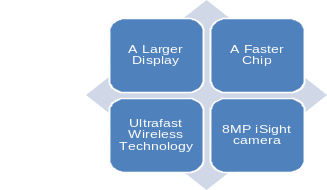Introduction
The focus will be on Apple’s recent model of iPhone 5 which is a thing to go for today. Figure 1 below will illustrate the main features of the iPhone 5 (Apple Inc., 2012):

Apple further states that iPhone 5 happens to be the thinnest and most portable iPhone model ever (Apple Inc., 2012). It also has a 4-inch Retina presentation that is also brilliant. It enables the user have a good view on everything in a more vivid and lifelike manner. Its ultrafast wireless does not consume much of the battery life while the headphones are appealing and have a comfortable fit (Apple Inc., 2012).
The iPhone product will have to overcome the challenges posed by changes in the market conditions where the same will impact on its promotional strategies and product mix approaches. It is anticipated that the launch of iPhone products to end users will have a faster pace. However, this is not to assume that there are many competitors in the market offering such gadgets at an affordable price. The other challenge may derive from pricing itself since it is expected that the users will have to pay more to secure iPhone 5. However, promotional strategies will focus on ensuring that the targeted market understands the benefits of iPhone 5 since it offers features and applications that may be used in critical operations such as business advancement. This may refer to the need for effective communications and statistical analysis just to mention a few. In general, the product life cycle for iPhone 5 will require a vibrant marketing strategy in order to command a good sale lead. Moreover, the issue of pricing remains core because there will be need to make the targeted market pay something worth. The distribution and promotion channels must be very thorough and more oriented to customer’s needs.
Further Analysis
Analyze the impact of channel management decisions on marketing?
It is important to note that channel management decisions refer to the approach through which a producer or manufacturer or supplier coordinate their marketing operations by incorporating other parties to the preferred channel of distribution (Kotler & Keller, 2012). For instance, if the selected distribution channel is not suitable for the product, then there would be a crisis in the efforts to reach out the targeted end user. Therefore, the channel management decisions should be conducted appropriately so that they do not impede other marketing strategies in place creating even further logistical problems.
What is a distribution channel? What is the relationship between channels of distribution and logistics? How does geographical location affect the selection of distribution channels?
A distribution channel refers to the channel framework through which a product or service goes through until it reaches the end user (Perreault et al., 2011). The reader is aware that a distribution channel involves a wholesaler, retailer, distributor and it may extend to the use of internet. The other point is that such channels may be subdivided further to include direct and indirect approaches. For instance, the direct channel enables the consumer to purchase the goods straight from the manufacturer. On the contrary, in the indirect approach, the consumer acquires the goods from the wholesaler. Direct channels are considered shorter compared to indirect ones (Perreault et al., 2011).
From the assertion above it can be seen that channels of distribution and logistics have symbiotic relationship. This is because decisions in logistics would depend more on the channels of distribution available. For instance, direct channels would have simpler demands for logistics. Moreover, if the end user is located at a far geographical territory then selected channels of distribution will have more demands. This would require a longer chain of distribution due to the long distance between the manufacturer and the end user.
What are the similarities and differences between promotional push strategies and promotional pull strategies? What is an example of a situation in which an organization would use a push strategy? What is an example of a situation in which an organization would use a pull strategy?
In promotional push strategies the focus is to utilize organization’s sales force as well as trade promotion strategies in order to establish consumer demand for a good or service. Thus, the manufacturer promotes the good or service to the wholesaler and the latter to the retailer and lastly to the consumer. In other words, the push criteria aim to trade the product directly to the consumer thus distancing from other distribution channels (Armstrong & Kotler, 2011). For instance, insurance or hospitality companies promote their products directly to consumers through effective consumer promotions and advertisements.
In the “pull” strategies an organization ends up spending very highly in advertising and consumer promotion in the effort to enhance consumer demand towards the good or service. In this regard, if the approach is fruitful, end users with request the retailers to supply them with the product; in turn the retailers will request the wholesalers to supply the product while the latter will reach out to the producer for supply of the same (Armstrong & Kotler, 2011). This kind of marketing is evident in big companies such as Coca-Cola.
References
Apple, Inc., (2012). iPhone. Web.
Armstrong, G. & Kotler, P. (2011). Marketing: An introduction. (10th ed.). Upper Saddle River, NJ: Prentice Hall.
Kotler, P. & Keller, K. L. (2012). Marketing management. (14th ed.). Upper Saddle River, NJ: Prentice Hall.
Perreault, W. D. Jr., Cannon, J. P., & McCarthy, E. J. (2011). Basic marketing: A marketing strategy planning approach. (18th ed.). New York, NY: McGraw-Hill Irwin.